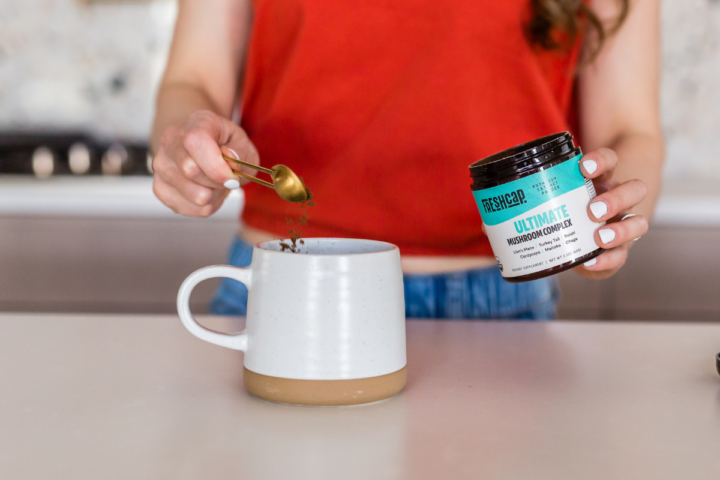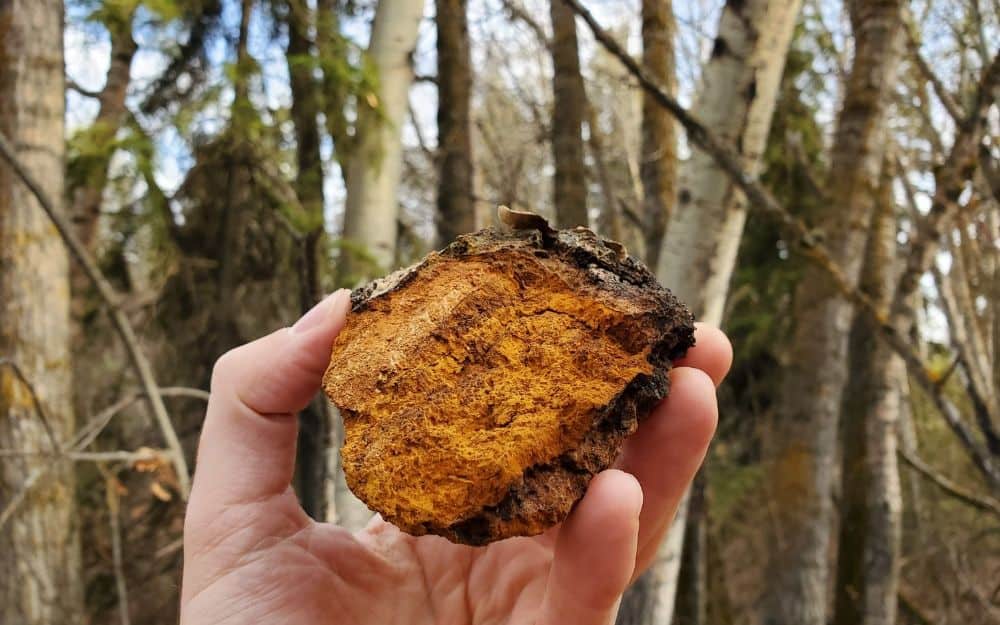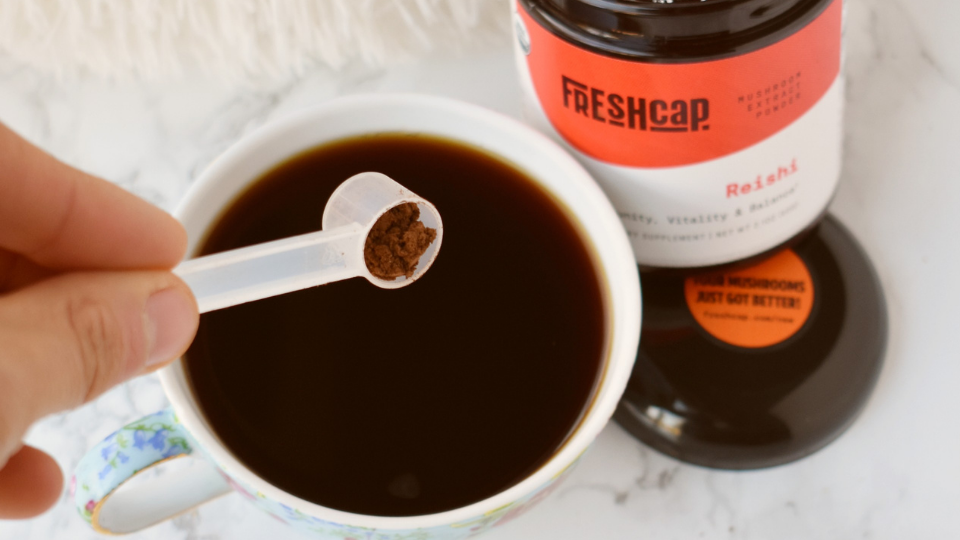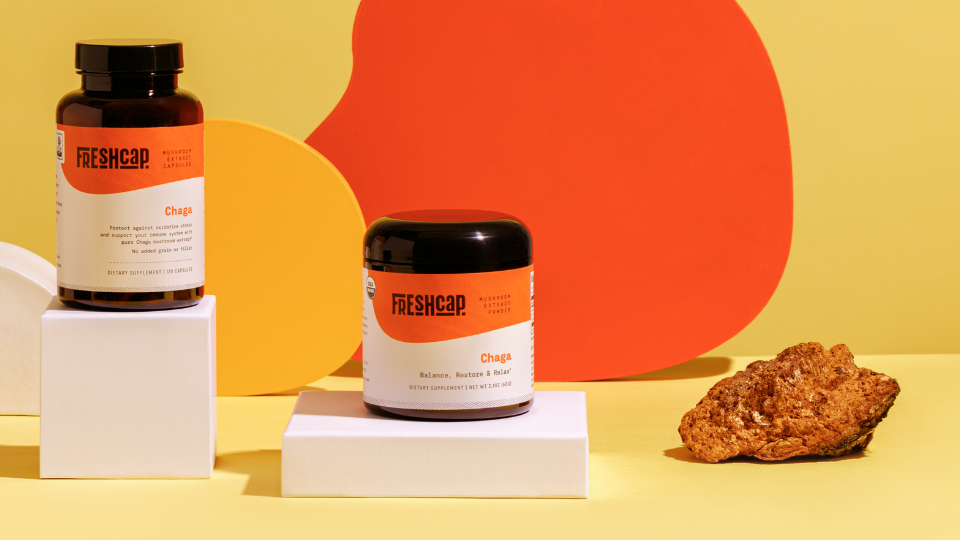How To Use Mushroom Powder: Everything You Need To Know

Like most people, you probably grew up eating mushrooms as a pizza topping or thrown into a salad every now and again. And, chances are, it was most likely white button mushrooms and maybe brown creminis.
How do we know this?
Because white button mushrooms account for 90% of mushrooms consumed in the U.S., and it’s been like this for quite some time. (1)
But that’s slowly changing. In recent years, mushrooms—particularly more exotic varieties such as shiitake, maitake, lion’s mane, turkey tail, chaga, reishi, and cordyceps—have taken center stage as celebrated superfoods.
No longer relegated as a food afterthought, mushrooms are increasingly valued as edible wonders thanks to their numerous health benefits including immune supporting, anti-inflammatory, antiviral, and so “mush” more. (2)
No wonder they’re not just called edible mushrooms—they’re also called functional mushrooms, or medicinal mushrooms.
Along with the growing popularity of medicinal mushrooms, the manner in which you can consume these healthful fungi has also expanded. In this case, we’re talking about mushroom powder.
What Is Medicinal Mushroom Powder?
Simply put, mushroom powder is made from dehydrated mushrooms that are then ground up into a fine powder. Some are first processed using hot water or alcohol extraction in order to pull out the beneficial compounds- which is important to achieve the full benefits. Some “mushroom powders” can also be made from myceliated grain.
While you can make mushroom powder yourself or buy it online or at your local health food market or Asian grocery store, it’s important to know that not all mushroom powders are the same.
Medicinal mushroom powders can be made from a single species or multiple mushroom varieties. They often include a variety of different mushroom extracts to maximize the specific health benefits of each type.
While there are over 2,000 species of edible mushrooms on the planet (that we know of), most powdered extracts are made from the medicinal mushrooms mentioned above.
How to Choose a Mushroom Powder
As with any food or supplement you buy, it’s essential to research the brands and read the labels. Many mainstream mushroom powders may seem like a healthy choice upon first glance. But once you look a little more closely, you might find a list of fillers, flavorings, stabilizers, preservatives, and artificial ingredients.
To make sure you’re choosing a mushroom powder that’s actually good for you, look for the following criteria:
- USDA Organic
- Non-GMO
- Third-party tested and verified
- 100% mushroom extract
- Gluten-free and vegan (if that’s important to you)

Why Should I Use Mushroom Powder?
Mushrooms are super low in calories, sodium, and fat, and are free from cholesterol, sugar, dairy, and gluten. They’re also loaded with vitamins, minerals, dietary fiber, antioxidants, and other powerful immune-boosting compounds known as beta-glucans. (3)
They’re also an excellent alternative to meat-centric dishes. Studies have shown that mushrooms not only offer similar texture and satiety as meat, but they also promote weight loss. (4)
Need we say more?
OK, then.
As wonderful as they are, we realize that you might not always be in the mood for the chewy consistency or earthy flavor of mushrooms. That’s where mushroom powder comes in.
Mushroom powder allows you to reap the rewards of eating mushrooms without feeling like you’re eating them. It’s also ideal if you don’t love the taste of mushrooms in general.
If you don’t consider yourself a mushroom lover, mushroom powder just might change your mind.
What Does Mushroom Powder Taste Like?
One of the biggest questions people have about mushroom powder is how it tastes. Eating mushrooms fried in a pan, breaded, or roasted in an oven is one thing. But ingesting powdered mushrooms in a smoothie or cup of coffee?
Well, that might sound downright unpalatable.
While it’s true that some mushrooms are stronger than others—for example, Reishi can be bitter and Cordyceps can be strong—but many mushrooms impart a subtle earthy flavor, especially in powdered form.
If you don’t like earthy tastes, the good news is that mushroom powders such as Thrive 6 complement a wide variety of food and beverages, and easily take on the flavor of whatever you’re adding it to.
As a result, you can enjoy all the benefits without any unwanted aftertaste.
4 Ways To Use Mushroom Powder
There are plenty of ways for you to use mushroom powder. Don’t be afraid to experiment and try new things. Below are some of the most convenient methods to get you started on your mushroom powder power trip.
1. Add It to Your Coffee And Tea

Mushroom coffee is kind of a big deal right now. While some can’t get enough its bold flavor in a morning cup of joe, you might want to consider adding oat milk or coconut creamer to dilute any mushroom flavor. Try these tasty options that mask any earthy pungency:
2. Shake It Up in Smoothies
You might think that adding mushroom powder to a smoothie is a recipe for disaster, but nothing could be further from the truth. Try using a small scoop (about a gram) in one of these must-try recipes:
- Golden milk smoothie
- Chia maca vegan milkshake
- Detoxifying green dream shake
- Energy boosting hero smoothie
3. Cook With Mushroom Powder
Aside from your hot and cold beverages, adding mushroom powder to your everyday foods is a convenient and effective way to gain the health benefits with virtually no effort.
Add some to your stir-fries, soups, salads, and pasta dishes for a hint of flavor. Mix it into your seasonings and sauces for chicken, meatloaf, tofu, tempeh, or hamburger patties for more flavorful complexity. It even works for sweet dishes, too.
Try it in these mushroom-powered recipes:
- Shiitake mushroom sliders
- Oyster souffle
- Zucchini sun-dried tomato pasta
- Coconut lentil soup
- Blondie brownies
4. Consider Capsules
If you’re still not sure about adding mushroom powder to your food and drinks, then consider taking it in capsule form. Some people prefer mushroom powder capsules because it provides an exact dosage vs. sprinkling it on food or beverages.
You can easily find encapsulated mushroom powder online and in stores. Just be sure to follow the same precautions as you would when shopping for powdered extracts.

How Much Mushroom Powder Should I Take?
Although there are no official rules on how much mushroom powder you should take, the general consensus is 1-3 grams per serving.
That said, if you have any health concerns or are in doubt, reach out to your doctor or healthcare practitioner beforehand. After all, every person is different and it’s always better to get medical advice before adding any new supplement to your diet.
Mushroom Powder: The Power is Yours
More than just a chewy, flavorful food, mushrooms are having a major moment thanks to their medicinal, health-enhancing properties. Traditional Chinese medicine and other cultures have known about the power of medicinal mushrooms for centuries, and now the rest of the world is finally catching up.
While eating fresh, cooked mushrooms is an ideal way to enjoy them, it’s not always practical. Perhaps you don’t like the taste or you’re simply craving something with a different texture. Whatever the case might be, mushroom powder is an excellent alternative and one of the best ways to add more mushrooms to your life.
Now that you know how to use mushroom powder and what to look for, it’s time to enjoy its many health benefits and make it a part of your overall healthy lifestyle.


Thanks for these tips re: mushroom powder…. Isaak Dostis
Hello, thanks for the article! I am wondering how to find info on the health benefits of consuming a mushroom powder in your coffee or smoothie compared to actually cooking with them (whether fresh or dried and reconstituted). I found a peer reviewed journal article studying the nutrition of one type of mushroom in Africa that revealed frying significantly boosts the nutritional value (as compared to boiling or microwaving), and that drying is a better way to preserve them than freezing. But I’m still unclear as to whether adding dried mushrooms to coffee actually conveys the benefits that mushrooms have to offer (since there is no cooking). I see you say that some brands will use hot water before drying. I presume this mimics the boil method of cooking? Wondering if you have any ideas for where to get more info, or if you know how to tell if a brand does this heating up front or not. The prices of these products are all over the map!
Hey Kathy, great question! Since the benefits of mushrooms are “locked up” inside the tough cell walls of the mushrooms, they need to be extracted in order to get the most benefit. This can be done via hot water extraction (ie making a tea from dried mushrooms) alcohol extraction, or both.
We start with dried mushrooms, perform a long hot water extraction to pull out the beta-glucans, and then spray dry the mixture into a fine powder. We also perform alcohol extractions on some mushroom species (Chaga, Reishi and Lion’s Mane).
Hope that helps!
Just put it in your cooking. Yumm. Nevermind mushroom tea or coffee 😜
Whats your formula? Approx how many grams/lbs mushrooms are used in the decoction process and what is the end result? or rather your yield. Curious about ppls recipes and ratios they use.
Hey! Thanks for the article. Is it 1-3 servings per mushroom or in general? If I try to combine powders what’s the rule so that I don’t overdo it? I might mix chaga and lionsmane in the am and reishi by itself in the evening. I know someone who’s trying to take turkey tail, reishi and chaga but the turkey tail is a tincture and the other two are powders. Thanks so much!
Do I have to use HOT liquid with the powder or is it fine To just add to a smoothie? I heard somewhere it needed to be hot.